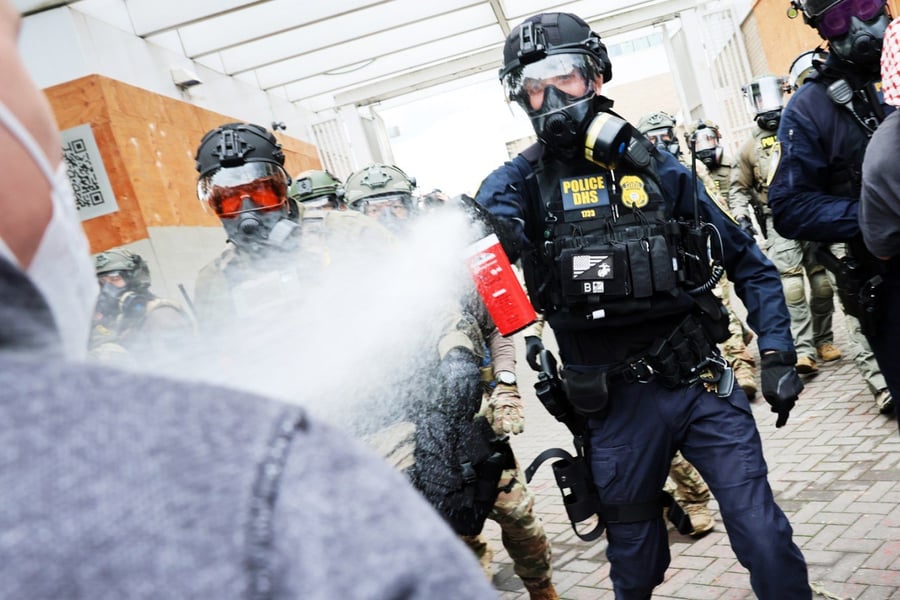On the first night, months ago, Prim thought she would just head down to see what the protests were all about. She left her job as a nursing assistant, still in her scrubs and N95 mask, and drove to the Immigration and Customs Enforcement facility on Macadam Street in South Portland, where demonstrations against the Trump administration’s immigration policies had started to flare up. She thought she might be able to take some photos. When she arrived, there weren’t many people there — a few knots of protesters on the sidewalks, huddled next to a smattering of residential buildings and a car parts shop. Macadam Street was empty. Prim went to cross, and was almost immediately shot at. Rubber bullets, pepper balls, and other projectiles whizzed by. From across the street, two black-clad protesters yelled at her. “Come to us! Come to us!” Stumbling and ducking, she made her way over. They told her the rules: ICE is over there. We are over here. They will shoot you if they can.
Four months later, Prim, who is 46, no longer works as a nursing assistant, and no longer wears scrubs. Instead, every night she dresses in black, in a helmet and gas mask, and works as a street medic treating the constant injuries of protesters in Portland. She has been shot in the head with non-lethal projectiles and breathed so much tear gas she coughed up blood. She doesn’t use her real name in interviews, or even on the street (Prim is one of several pseudonyms). Prim the nursing assistant didn’t know anything about the concept of “black bloc,” where protesters dress in nondescript black clothing to hide their identities. Prim the street medic wears it every night, attempting to conceal her identity from a government that has made it explicitly clear that she is an enemy of the state.
For the past 10 years, the core of many of America’s myriad protest movements has been dedicated activists who promote an ethos of “anti-fascism,” a nebulous term that has been used in opposition to police violence, brutal immigration policies, and widespread oppression of minority groups like the LGBTQ community. The right has taken this ideology and made it into a boogeyman: the specter of “antifa,” a shadowy network of far-left radicals hell bent on tearing apart the country. Antifa, as the right describes it, does not exist. There are no central leaders, no national organizations, no official members. But the term stuck, and the second Trump administration is determined to use a fabricated enemy to usher in a new wave of repression that could stifle dissent for years to come.
On September 22, the Trump administration issued a decree that designated “antifa” as a domestic terrorist organization, claiming it is a “militarist, anarchist enterprise that explicitly calls for the overthrow of the United States Government.” Three days later, the administration issued National Security Presidential Memorandum 7, a sweeping document that links anti-fascist organizing with several instances of political violence, including the assassination of Charlie Kirk, and lays out an extremely broad framework potentially allowing federal law enforcement to prosecute any entity deemed to be supportive of that ideology. Now, anti-fascist activists around the country say that the two proclamations have ratcheted up pressure they’ve felt for years, making street-level organizing more dangerous than ever before.
“It’s completely changed [since NSPM-7],” Prim says. “We now have an open target on us.”
The ICE agents that clash with protesters in Portland, she says, are barely trained and quickly resort to violence. They fire rubber bullets at protesters’ heads and slip rock-hard marbles into the hoppers of their pepper-ball guns. They’re often joined by a motley assortment of right-wing agitators — big-rig drivers who menace crowds on the street, right-wing “journalists” who try to infiltrate groups of protesters and dox them online, and the dregs of street gangs like the Proud Boys who show up spoiling for fights. The situation, Prim says, feels more dire by the day.
“A lot of us on the ground have already made wills,” Prim says. “I said goodbye to my brother two weeks ago, just in case. He knows there’s a good chance I don’t make it out of this.”
Love Music?
Get your daily dose of everything happening in Australian/New Zealand music and globally.
Portland’s protests, for the time being, are persisting in the face of Trump’s new proclamation and ICE’s heightened use of force. But in other parts of the country, NSPM-7’s effects have driven organizing networks completely underground. Activists have wiped group chats and canceled meetings, scrubbing their online presences and often taking a step back from organizing. Almost everyone Rolling Stone spoke to for this story asked to use a pseudonym for fear of retribution. Others spoke on background or off the record. Anti-fascist networks have always had a strong security culture — encrypted messaging apps are the norm, and people are guarded with their identities — but the administration’s broad declaration of “antifa” as terrorists has pushed those practices into overdrive.
“This shit is not new, it’s just more overt now,” says Ned, an Appalachian anarchist who is dedicated to arming marginalized communities, like queer and trans people, with firearms. Trump’s rhetoric has spooked many people he works with, and inspired others to formalize their security plans and protocols. But while online chatter may be more reserved, he says his actual work — hosting range days for queer and trans people to learn to shoot, and distributing information on how to 3D print weapons from scratch at home — is busier than ever.
“Direct action has been driven even further underground,” Ned says. “If anything there’s more of it, it’s just not online.”
But real life can get messy, fast. Trump’s initial proclamations came in the immediate wake of the Charlie Kirk shooting, and referenced instances of violence like Luigi Mangione’s killing of health care CEO Brian Thompson. While the everyday activities of most anti-fascist activists are still overwhelmingly peaceful, the Trump administration has capitalized on every instance of political violence and used them to usher in new crackdowns and waves of propaganda. In early October — as the president was busy claiming that activist “thugs” were turning cities like Portland into “war zones” — the administration hosted a rouges’ gallery of far-right influencers and media figures at the White House to give them a forum to decry “antifa,” using them to further push its message that the group was a national threat.
The administration’s stance is evident in its response to real-life violence, as well, which has left activists on the ground scrambling. In Texas, for instance, shootings at two ICE facilities prompted a swift and total crackdown, demolishing fragile networks of activists and bringing a new wave of federal charges. One of the shootings, an attack on ICE officers outside of a detention facility south of Dallas, was perpetrated by a man formerly associated with a loose network of left-wing gun-rights organizations that rose to prominence in 2023. The government arrested at least 14 people in connection with the shooting, charging 11 of them with attempted murder and “terrorism-related offenses,” per The Washington Post. Discords, group chats, and social media accounts were scrubbed overnight, as the FBI raided houses. One source told me that even innocuous, long-standing groups like local Food Not Bombs chapters started wiping data and battening down the hatches, fearing that the federal crackdown wouldn’t stay contained to those accused of an actual crime.
“People got scared, and they haven’t really come back,” said Corey Lyon, a local journalist who has covered protests throughout Texas. “A lot of the community that was built around activism, around helping our community, has been completely gutted.”
Part of the reason these crackdowns have been effective is that they’ve been tested before — including in Atlanta, where the state of Georgia’s campaign to label protesters as domestic terrorists has crushed the structure, if not the spirit, of the Stop Cop City movement. The movement began in 2022, when the city of Atlanta released plans to build an expansive police training facility in a forested area of land on the outskirts of the city. In response, a flourishing protest encampment sprang up in the forest, morphing into a years-long battle between police and activists that left one person, Manuel “Tortugita” Teran, dead after a police shooting. In a shocking weaponization of the justice system, Georgia Attorney General Christopher Carr used a 2017 statute passed after the Dylann Roof shootings to arrest and charge dozens of protesters with “domestic terrorism,” holding them in pre-trial detention for lengthy periods and snarling them in a legal web of denied bail, compounding charges, and jurisdictional chaos. Carr then went after the activists’ support networks, bringing RICO charges against a local bail fund and several other community organizers.
President Trump has clearly learned from these tactics, floating the idea of slamming George Soros and various networks of left-wing nonprofits with RICO charges based on their connections to protests. In Georgia, many of the charges, and many of the cases entirely, have been dropped or shot down by rational judges. But activists say that the initial shock of prosecution was the whole point.
“The formal legal underpinnings of these tactics can’t hold water,” says Marlon Kautz, a spokesperson for the Atlanta Solidarity Fund, the bail relief organization that was slapped with RICO charges. “But that doesn’t matter, because the goal is not successful prosecution, it’s the disruption of their political adversaries.”
Kautz himself was arrested in May 2023, when a joint task force of Georgia authorities raided his house in SWAT gear. From his bedroom, he heard officers discussing whether or not to throw a flash bang grenade through the front door. The point of all this, Kautz says, is to create fear.
“The objective is to make [activists] feel as if the safest smartest thing to do is to disengage with political activism until things cool down,” Kautz says. “The challenge is how to continue being an activist in the face of that fear. Because giving in to that fear is just defeat. There is no way to succeed by taking a step back or keeping your head down for a while.”
In Portland, Chicago, Los Angeles, New York, and many other cities, plenty of activists aren’t keeping their heads down. Some protesters have taken to showing up in whimsical costumes: inflatable frogs, chicken suits, giant foam hot dogs, and more. Many of these protests are peaceful, especially the ones that draw large crowds of everyday Americans upset with Trump’s increasingly authoritarian administration. But there are always men in uniforms with guns. There are always fingers on triggers.
“We can’t predict what is going to happen,” Prim, the medic in Portland, says. “All we can do is be as mentally prepared as possible — to take care of each other not only on the ground, but outside of it as well.”
Prim isn’t alone. In Atlanta, new groups of activists have taken up the mantle of those facing court cases. While Texas’ highly-visible left-wing gun clubs may have faded, range days for vulnerable groups and 3D-printed schematics for weapons are more popular than ever. Some anti-fascists have dropped out of activism entirely in response to the Trump administration’s crackdown, but plenty are staying busy, learning to adjust to a new, openly-hostile government. Some are peaceful. Some are not. All of them want to stop what they see as the rise of a fascist regime in the United States.
“They paint us as these thugs and delinquents, these terrorists,” Prim says later, in a message on Signal, the encrypted messaging app. “It is us who know who the real terrorists are.”
From Rolling Stone US



































